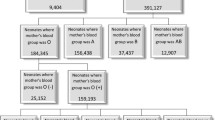Abstract
Background
The most common cause of jaundice during pregnancy in the United States (US) is still attributed to viral hepatitis, despite the dramatic drop in incidence of viral hepatitis in the US.
Objective
We hypothesized that viral hepatitis is no longer a frequent etiology of jaundice among the pregnant population in the US and sought to identify the contemporary causes of elevated bilirubin during pregnancy as well as to quantify the associated risk to the mother and fetus.
Study Design
Clinical data from all pregnant women who delivered an infant between 2005 and 2011 at a single hospital in Dallas, Texas, were ascertained using prospectively collected computerized databases. Women with elevated total bilirubin (>1.2 mg/dl) were analyzed to determine the cause of hyperbilirubinemia and maternal and fetal outcomes.
Results
Out of a total of 80,857 consecutive deliveries, there were 397 (0.5 %) pregnancies with hyperbilirubinemia. The most common etiology was gallstones (98/397 = 25 %), followed by preeclampsia/eclampsia/HELLP (94/397 = 24 %) and intrahepatic cholestasis of pregnancy (53/397 = 13 %). Adverse infant outcomes, including stillbirths, fetal malformations, neonatal deaths, and small for gestational age births, were more common in the women with hyperbilirubinemia during pregnancy, but there were no maternal deaths.
Conclusions
Acute viral hepatitis is no longer a common cause of jaundice in pregnant women in the US. In the current era, gallstones and preeclampsia-related disorders are the most common causes of jaundice in pregnant women. Disorders that cause elevated maternal bilirubin during pregnancy are associated with increased risk for the fetus.


Similar content being viewed by others
References
Harish K, Nitha R, Harikumar R, et al. Prospective evaluation of abnormal liver function tests in pregnancy. Trop Gastroenterol. 2005;26:188–193.
Ch’ng CL, Morgan M, Hainsworth I, Kingham JG. Prospective study of liver dysfunction in pregnancy in Southwest Wales. Gut. 2002;51:876–880.
Devarbhavi H, Kremers WK, Dierkhising R, Padmanabhan L. Pregnancy-associated acute liver disease and acute viral hepatitis: differentiation, course and outcome. J Hepatol. 2008;49:930–935.
Ahmed KT, Almashhrawi AA, Rahman RN, Hammoud GM, Ibdah JA. Liver diseases in pregnancy: diseases unique to pregnancy. World J Gastroenterol. 2013;19:7639–7646.
Kamimura K, Abe H, Kawai H, et al. Advances in understanding and treating liver diseases during pregnancy: a review. World J Gastroenterol. 2015;21:5183–5190.
Hay J. Viral hepatitis in pregnancy. Viral Hepat Rev. 2000;6:205–215.
Riely CA. Hepatic disease in pregnancy. Am J Med. 1994;96:18S–22S.
Mishra L, Seeff LB. Viral hepatitis, A though E, complicating pregnancy. Gastroenterol Clin North Am. 1992;21:873–887.
Sookoian S. Liver disease during pregnancy: acute viral hepatitis. Ann Hepatol. 2006;5:231–236.
Hay JE. Liver Disease and Pregnancy. In: Hauser, SC, Pardi, DS, Poterucha, JJ, editors. Mayo Clinic gastroenterology and hepatology board review. 3rd ed. Mayo Clinic Scientific Press; 2008. p. 419–430.
D’Cruz IA, Balani SG, Iyer LS. Infectius hepatitis and pregnancy. Obstet Gynecol. 1968;31:449–455.
Naidu SS, Viswanathan R. Infectious hepatitis in pregnancy during Delhi epidemic. Indian J Med Res. 1957;45:71–76.
Haemmerli U. Jaundice during pregnancy. Acta Med Scand. 1966;444:23–30.
Bennett NM, Forbes JA, Lucas CR, Kucers A. Infective hepatitis and pregnancy: analysis of liver function test results. Med J Aust. 1967;2:974–976.
Cahill KM. Hepatitis in pregnancy. Surg Gynecol Obstet. 1962;114:545–552.
Peretz A, Paldi E, Brandstaedter S, Barzilai D. Infectious hepatitis in pregnancy. Obstet Gynecol. 1959;14:435–441.
Adams RH, Combes B. Viral hepatitis during pregnancy. JAMA. 1965;192:195–198.
Hieber JP, Dalton D, Shorey J, Combes B. Hepatitis and pregnancy. J Pediatr. 1977;91:545–549.
Hay JE. Liver disease in pregnancy. Hepatology. 2008;47:1067–1076.
Disease burden from viral hepatitis A, B and C in the United States. Available at: http://www.cdc.gov/hepatitis/pdfs/disease burden.pdf.
Table 1: Reported cases of acute viral hepatitis, by type and year, United States, 1966–2003.
Table 2.1 Reported cases of acute hepatitis A, by state—United States, 2006–2010. Viral Hepatitis Statistics & Surveillance. Centers for Disease Control and Prevention. Available at: http://www.cdc.gov/hepatitis/Statistics/2010Surveillance/Table2.1.htm.
Wong HY, Tan JY, Lim CC. Abnormal liver function tests in the symptomatic pregnant patient: the local experience in Singapore. Ann Acad Med Singapore. 2004;33:204–208.
Borhanmanesh F, Haghighi P, Hekmat K, Rezaizadeh K, Ghavami AG. Viral hepatitis during pregnancy. Severity and effect on gestation. Gastroenterology. 1973;64:304–312.
Cunningham FG, Leveno K, Bloom SL, Hauth JC, Rouse DJ, Spong CY. Appendix. Reference Table of Normal Laboratory Values in Uncomplicated Pregnancies. Williams Obstetrics. 23rd ed.
Bacq Y, Zarka O, Brechot JF, et al. Liver function tests in normal pregnancy: a prospective study of 103 pregnant women and 103 matched controls. Hepatology. 1996;23:1030–1034.
Larsson A, Palm M, Hansson LO, Axelsson O. Reference values for clinical chemistry tests during normal pregnancy. BJOG. 2008;115:874–881.
Lockitch G. Clinical biochemistry of pregnancy. Crit Rev Clin Lab Sci. 1997;34:67–139.
Liddle RA, Goldstein RB, Saxton J. Gallstone formation during weight-reduction dieting. Arch Intern Med. 1989;149:1750–1753.
Amaral JF, Thompson WR. Gallbladder disease in the morbidly obese. Am J Surg. 1985;149:551–557.
2010 US Census data-Dallas County. Available at: Dallas County, Texas. American FactFinder. US Department of Commerce. United States Census Bureau. http://factfinder2.census.gov/faces/nav/jsf/pages/community_facts.xhtml.
Newsroom; U.S. Census Bureau Projections Show a Slower Growing, Older, More Diverse Nation a Half Century from Now. Available at: http://www.census.gov/newsroom/releases/archives/population/cb12-243.html.
Overweight and Obesity: Adult Obesity Facts. Available at: http://www.cdc.gov/obesity/data/adult.html.
Author information
Authors and Affiliations
Corresponding author
Ethics declarations
Conflict of interest
The authors report no conflict of interest.
Electronic supplementary material
Below is the link to the electronic supplementary material.
Rights and permissions
About this article
Cite this article
Duraiswamy, S., Sheffield, J.S., Mcintire, D. et al. Updated Etiology and Significance of Elevated Bilirubin During Pregnancy: Changes Parallel Shift in Demographics and Vaccination Status. Dig Dis Sci 62, 517–525 (2017). https://doi.org/10.1007/s10620-016-4282-3
Received:
Accepted:
Published:
Issue Date:
DOI: https://doi.org/10.1007/s10620-016-4282-3




